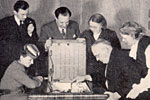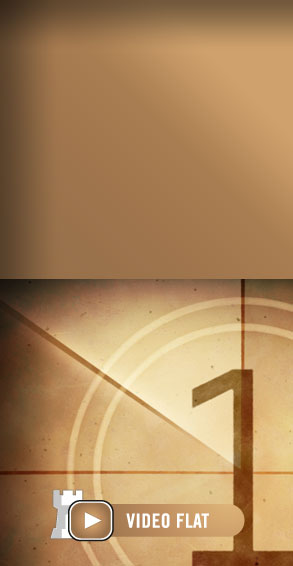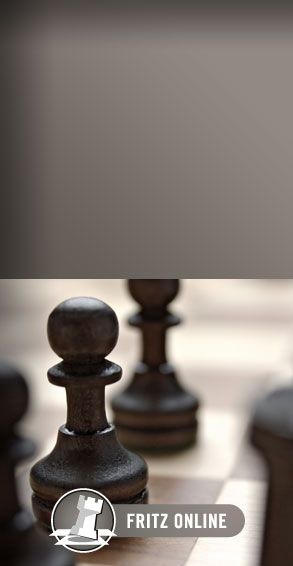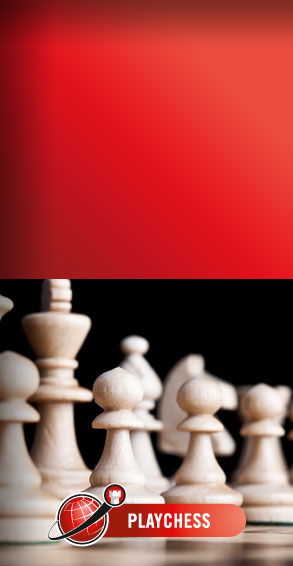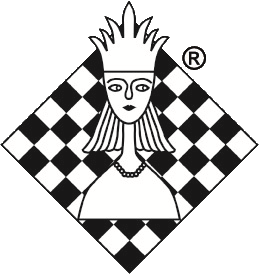Chess After the War

CHESS Magazine was established in 1935 by B.H. Wood who ran it for over fifty years. It is published each month by the London Chess Centre and is edited by John Saunders. The Executive Editor is Malcolm Pein, who organised the London Chess Classic.
CHESS has just published its March 2010 issue, a 75th anniversary edition and made a very interesting article on Chess in the War available to ChessBase.com readers. CHESS is one of most popular English language chess publications and one of the very few in A4 colour format.
A look into the magazine in the immediate post-war period
The war is over. Let joy be unconfined! It was quite remarkable how quickly international competition was re-established after the world war, though there was still a little unfinished business to be sorted out first. From the distance of the 21st century, we tend to think of Alexander Alekhine as a pre-war champion but of course he was still very much alive at the immediate cessation of hostilities in 1945, though understandably none too popular in some quarters and evidently at a very low ebb. The October 1945 issue reported on his result at a tournament in Gijon, Spain, where he failed to perform as a world champion should, finishing level with Medina, a point and a half behind the winner Rico. “Alekhine’s defeats” was the headline and the final line “can Alekhine raise himself out of the pit?”.
In truth he never did. The psychological reason for Alekhine’s poor form was obvious enough. The world’s opprobrium as a suspected Nazi collaborator must have weighed heavy on him. One only has to turn a few pages from the Spanish tournament report to read a Dutch federation official’s opinion of him as reported in the magazine (“small-minded drunkard with his lust for money” is one reference). Alekhine wasn’t the only player to have aspersions cast upon him: the editor BH Wood refers to the Austrian player Eliskases as being a “fervent Nazi” at the outbreak of war (though he leaves open the possibility that he may have changed his politics after becoming domiciled in South America for the duration). Some correspondents found it in them to be more charitable to Alekhine and voice the sentiment that his wartime activities were for the relevant authorities to investigate and judge, and not the chess world. Alekhine himself disclaimed responsibility for Nazi propaganda written under his name and claimed the threats to the well-being of his invalid wife had forced him to co-operate to the extent that he had. The vexed issue of Alekhine’s wartime activities became purely a matter for historians in March 1946 when news of his lonely death in Portugal came through. Ironically, the report was received only the day after the British Chess Federation met to discuss arrangements for a future title match between him and Botvinnik. Alekhine was 53 years old at death, only just surpassing the lifespan of his great rival Capablanca.
Another more poignant feature of the magazine in 1945 and 1946 was the re-establishment of contact between chessplayers across the world. Sometimes the news was good, with the displaced/missing person found safe and well, but often the news (or lack of it) was desperately sad – many distressing stories were told of chessplayers who perished during the conflict.
One largely unmourned demise was that of William Joyce – the notorious “Lord Haw-Haw”, who broadcast radio propaganda for the Nazis during the war and was condemned to death for high treason in 1945. The February 1946 issue told of his playing chess in the condemned cell immediately prior to his execution as a traitor at Wandsworth Prison on 3 January 1946. It quoted a newspaper snippet: “he concentrated on his moves without the least sign of strain.”
The match of the (mid) century
The first major chess event of the post-war era was the USSR versus USA radio match played in September 1945, at a time when ‘hot war’ was over but it had not yet turned into the cold variety. This ten-a-side double-round event marked a watershed. Between the wars, the USA had established itself as the world’s top chessplaying nation, winning the Olympiad gold medals four times in a row between 1931 and 1937 (they did not compete in 1939). But the USSR team overpowered them in both rounds, winning 8-2 and 7½-1½ respectively, making it clear that the Soviet Union was now the one and only chess superpower. Of the Soviet players, Botvinnik was already a known member of the world elite with some stellar pre-war performances abroad but this result showed that Nikolai Krylenko’s ‘five year plan’ for Soviet chess in the 1930s had borne fruit and that there were now some other world-class Soviet players almost as good as Botvinnik. Writing about the match in Izvestia, Botvinnik outlined the background to the tremendous upsurge in Soviet chess: “suffice to mention that about 700,000 players participated in the 1937/38 USSR Trade Union Championship”. Commenting after the event, Botvinnik thought that where his side might have proved vulnerable was on the boards where young, inexperienced Smyslov and Boleslavsky faced established stars Reshevsky and Fine respectively but even on those boards the young Soviets were victorious. Krylenko never lived to see his dream come to fruition, having been denounced, tried and shot in 1938.
UK chess was also back in full swing, with pages given over to club and county activity. The Hastings Victory Congress (as it was styled) took place in 1945/46 and won by Tartakower who, as the magazine informed us, sought to be domiciled in Britain, having spent his war service here. The disappointment at Hastings was the non-appearance of the Soviet players, as was the case again immediately afterwards at the prestigious ‘Sunday Chronicle’ tournaments held in London during the second half of January 1946 (played in two sections, won respectively by Herman Steiner and Max Euwe). To be fair to the Soviets, travel at the time was extremely problematic. As the nameless Hastings reporter (probably BHW) put it: “Europe is a very sick man these days; every country is fenced in with currency and visa restrictions; trains and boats are slow and loaded with priority cargoes and a legacy of political difficulties has been left by war.” Hastings, of course, had seen front-line action itself, being both bombed and shelled, but the revival of the well-loved congress was a welcome sign of things returning to normal.

The editor estimated that the London tournaments received ten times as much publicity as Hastings. One imagines that having a newspaper sponsoring the London event helped considerably but the public was also much taken with 14-year-old Arturito Pomar. The young Majorcan was a prodigy in the mould of Capablanca and Reshevsky. A couple of years previously, as a 13-year-old, he had made a draw with world champion Alekhine in a tournament game. Despite the plethora of young chessplayers’ achievements in the modern era, no subsequent chess star has equalled that particular record. In London, Arturito made a middling but creditable score. After the tournament, at the Gambit Rooms, he won the following game against the famous veteran Jacques Mieses, then aged 80.
The octogenarian blundered badly at the end but one should not get the impression that he was senile by then. Only two months previously he had defeated Gerald Abrahams 4½-1½ in a match and was said to be keen to receive an invitation to play in the Hastings Premier for 1945/46 (as the sole survivor of the players who competed in the famous 1895 Hastings tournament fifty years before).
Honours for code-crackers
Hugh Alexander and Stuart Milner-Barry were both rewarded for their wartime code-breaking work at Bletchley Park with the award of the OBE (Order of the British Empire) in the 1946 New Year’s honours list. The editor could not have known (or at least could not have published) the details of what they had done, referring to it only as “confidential work”. Milner-Barry was evidently still busy as he could not obtain leave to take part in the Beverwijk tournament, which took on an international flavour for the first time (we know it better as Wijk aan Zee, of course). In June 1946 Britain had a chance to see if they could do better than the USA in a radio match with the USSR. They did – just – and this was in no small measure thanks to a sterling effort from Alexander, who defeated Botvinnik in the second round. The scores in the men’s match were 2½-7½ and 3½-6½, while the women’s match was a 0-4 whitewash in favour of the Soviets. William Winter (who beat Bronstein) and Gerald Abrahams (who beat Ragozin) were the other British game winners.
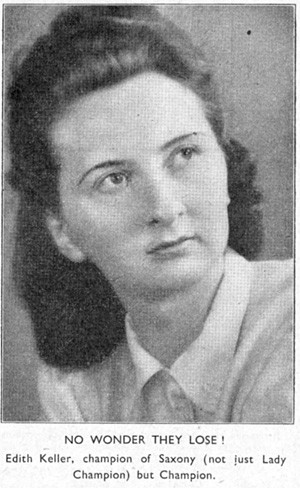 |
Maybe they lost because she played better moves than them? But the word ‘sexism’
probably didn’t exist in 1949. WGM Edith Keller-Hermann (1921-2010) later played for
East Germany in Women’s Olympiads. |
Hugh Alexander’s great achievement in beating the best player in the world came just two months after he had suffered the indignity of being challenged to a game by an old gentleman on a train (who had spotted his pocket set) – and being beaten! Alexander had managed to win a return game against his unknown conqueror but, to add insult the injury, the old gentleman had commented “when I saw ‘Hampshire Chess Association’ on one of your score books, I was afraid you might be a strong player.” Ouch! Of course, the source for the story was Alexander himself – someone who, like the hypothetical hero of Kipling’s famous poem, could “meet with Triumph and Disaster and treat those two impostors just the same”.
Remembering Reshevsky
2011 is the centenary of Samuel Reshevsky’s birth (26 November 1911 was his date of birth) and he was perhaps at his zenith in the late 1940s and early 1950s. That said, he had a very long stay amongst the chess elite, arguably joining in the mid-1930s and remaining there until about 1970. Only a handful of players can rival his longevity at the pinnacle of world chess.

In the period we are looking at, Reshevsky had some very good results when he played, though that wasn’t so often compared with other leading championship contenders (and certainly when compared to elite players today). At the Pan-American tournament in Hollywood in July-August 1945 he had scored 10½/12, a point and a half ahead of Fine and leaving a strong field in his wake. That cemented his status as the USA’s top player but two months later came the chastening 0-2 defeat by Smyslov in the radio match. As was often the case in Reshevsky’s career, there were murmurings about the inadequacy of his opening preparation. This was an area in which the new generation of Soviet players excelled and was the key that unlocked the door of modern professional chess. Reshevsky, however, was never truly a professional player – he was an accountant by profession and that was how he earned his living. Of course, this makes his stellar chess career all the more remarkable.
Reshevsky bounced back with another thumping victory in the 1946 US Championship in New York. He came close to defeating Botvinnik in the first game of the 1946 USSR-USA match but drew. Their second game was a classic, with Reshevsky making a mess of the opening but brilliantly clawing his way back to equality. Sadly, time pressure told and he blundered on move 41. Even so he would probably have survived against anyone other than Botvinnik, whose impeccable endgame play brought a Soviet victory.
Reshevsky’s next big-time chess was not until the World Championship Tournament of 1948. This unique event was necessitated by Alekhine’s death in 1946 and only came about after much wrangling and politicking. Reshevsky made a plus-one score of 10½/20 overall, beating Keres 3-2 and Euwe 4-1 but he lost 2-3 to Smyslov and 1½-3½ to Botvinnik. He finished only half a point behind Smyslov but 3½ points adrift of the new world champion. This wasn’t to be the end of the Botvinnik-Reshevsky – we’ll pick up the story in a later article.
BH Wood, present in Amsterdam for the 1948 championship tournament, is a little scathing about the arrangements. “We learn that the Championship is be held (oh dear!) in the Zoo. Now the comic-strip artists can really let themselves go. The World Championship Trophy... is exhibited in a shop window. We hate to be unkind but cannot get over the feeling that it is not quite worthy of the event.” Later, Reshevsky comes in for some stick: “I... saw Reshevsky simply exuding self-importance – it made someone recall how throughout the Stockholm tournament [presumably the Olympiad in 1937 – ed] he paraded with a rather gaudy belt across his stomach with chains, medals, etc, and inscribed in large letters “CHESS CHAMPION OF THE USA” – all this producing a rather sickly look on Fine’s face whenever he saw it.”
In round four there occurred Reshevsky’s first championship clash with Botvinnik, against whom he had a pre-championship overall head-to-head score of 1½-3½. Reshevsky was close to winning but the result hinged on his dubious clock-handling.
It’s all too easy to say but perhaps a positive result in that game might just have changed the course of chess history. At the end of the Dutch phase of the tournament, Reshevsky was in second place on 4½/8 behind Botvinnik on 6/8. More than two weeks elapsed before they were sitting at the board again after the transfer to Moscow. Reshevsky lost his first game there – his only loss to Smyslov – and, eight days later, lost his next game, to Keres. That was effectively the end of any hope he had of becoming world champion. True, in his third game in Moscow, he inflicted on Botvinnik his first defeat of the event with Black, but this still left him 2½ points adrift of the leader and a point behind Keres. Botvinnik romped home with four rounds to go and the fifth and final cycle of the event may as well not have been played.
But Reshevsky’s win against the soon-to-be champion was worth the trip to Moscow. BH Wood said of it: “an excellent game by the American champion which, for the power of its positional play, recalls his great win over Capablanca at Margate [1935].” Here it is, with Reshevsky’s own notes from the Russian bulletin of the tournament.
The original electronic chessboard
There’s nothing so new as what has been long forgotten... the photos below the forerunner to the modern electronic chessboard, featured in the February 1946 issue. Art Fey of Hazleton, Pennsylvania, was the inventor. As the players made their move, the device would print the score on a roll of paper which would come out of the side like ticker tape.

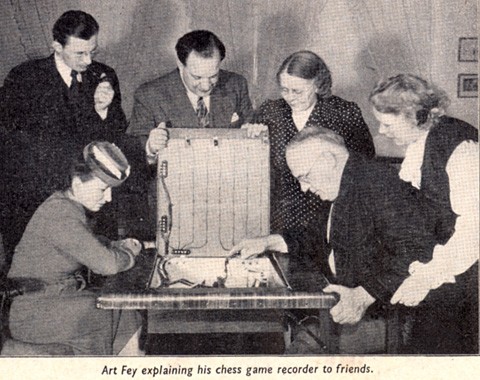
PDF downloads
CHESS is mailed to subscribers in over 50 countries. You can subscribe from Europe and Asia at a specially discounted rate for first timers here or from North America here.
